Team:Peking/DataPage
From 2012.igem.org
Zhangzidong (Talk | contribs) |
Zhangzidong (Talk | contribs) |
||
| Line 40: | Line 40: | ||
<div class="floatC"> | <div class="floatC"> | ||
<img src="/wiki/images/c/c3/Peking2012_light_communication_3.png" alt="Figure 1" /> | <img src="/wiki/images/c/c3/Peking2012_light_communication_3.png" alt="Figure 1" /> | ||
| - | <p class="description">Figure 1. | + | <p class="description">Figure 1. TOP10 cells harboring the luxbrick were cultured in LB medium and induced with L-arabinose at 10-3M. 10 hours after induction, the glowing cells were measured for spectrum using SHIMADZU RF5301PC Spectrofluorophotometer.</p> |
</div> | </div> | ||
<p>The time course of luxbrick expression and blue light emission under L-arabinose induction was given in a more visualized way, which is a short movie. As shown in the movie, the cells transformed with luxbrick begin to glow 9 hours after induction, and the entire visible glowing process lasts about 10 hours.</p> | <p>The time course of luxbrick expression and blue light emission under L-arabinose induction was given in a more visualized way, which is a short movie. As shown in the movie, the cells transformed with luxbrick begin to glow 9 hours after induction, and the entire visible glowing process lasts about 10 hours.</p> | ||
<div class="floatC"> | <div class="floatC"> | ||
| - | < | + | <div id="vedio" style="margin:0 auto;padding:0 10px;"> |
| + | <iframe width="600" height="400" src="http://www.youtube.com/embed/fnhe1MKIO9Q" frameborder="0" allowfullscreen=""></iframe> | ||
| + | <!-- <embed src="http://player.youku.com/player.php/sid/XNDU0NDU0NDcy/v.swf" quality="high" width="600" height="400" align="middle" allowScriptAccess="sameDomain" allowFullscreen="true" type="application/x-shockwave-flash"></embed> | ||
| + | --> | ||
| + | <br />if you can not view this video,please click <a href="http://v.youku.com/v_show/id_XNDU0NDU0NDcy.html">HERE</a>. | ||
| + | </div> | ||
<p class="description">Movie1. the time course of our light emitting cell</p> | <p class="description">Movie1. the time course of our light emitting cell</p> | ||
</div> | </div> | ||
Revision as of 05:46, 25 September 2012
Data for favorite parts
Optimized Luminesensor(BBa_K819005) a fusion protein consisting of an E. coli endogenous SOS system repressor LexA, carrying mutations at positions 40-42, and fungus N. crass photosensor protein VVD, carrying mutations N56K, C71V and M135 I. This part serves as an ultra-sensitive photoreceptor which can sense light as weak as moonlight and will induce light-dependent repression of genes with their promoters containing mutated 408 forms of the SOS box.
Testing device for Luminesensor(BBa_K819006) and measurement device for Luminesensor(BBa_K819007) a fast degrading GFP ligated to the downstream of SulA and RecA promoters, both in 408 form (only recognizable by our LexA-VVD fusing protein, not by E.coli endogenous LexA). The SulA promoter, which belongs to the SOS regulon family, promotes the expression of SulA protein gene which expresses SulA protein, a cell division inhibitor. The RecA promoter promotes the expression of RecA protein, which cuts the dimerized LexA protein in response to double strand break. When E. coli cells co-transformed with our luminesensor plasmid and light-responsive reporter plasmids are illuminated by blue light, the LexA408-VVD fusion protein expressed within the cell will dimerize in response to the light. The dimerized LexA408 domains will bind the SOS box (in 408 form) of both the SulA408 promoter and RecA408 promoter to inhibit the transcription of the downstream gene so that no GFP will be expressed. If the surrounding environment is dark, the luminesensor will not dimerize and no supression of the promoters will occur, leading to the expression of GFP.
Data for optimized parts
Lux Operon under T7 promoter (BBa_K819008)
We successfully improved the easy-of-use of “lux brick” (BBa_K325909) part constructed by Cambridge 2010 iGEM team by putting the coding sequence of luxbrick in the downstream of T7 promoter (BBa_I712074).
Luxbrick under T7 promoter is more modular because it is transcribed by T7 polymerase, which can be put under any other promoter, forming an interface between luxbrick and other systems, and thus making it more convenient to use luxbrick in complex systems.
Data for other submitted parts
this also comes later.
Data for existing parts
luxbrick (BBa_K325909)
luxbrick is a bacteria luciferase part constructed by Cambridge 2010 iGEM team. They successfully expressed bacteria luciferase in E.coli, which could produce blue light under L-arabinose induction, and they carefully characterized this part. But because there are data we need while they didn’t give, we made the following supplementary characterization.
The spectrum of the light emitted from E.coli harboring luxbrick was measured and it showed a maximum intensity at 485nm.

Figure 1. TOP10 cells harboring the luxbrick were cultured in LB medium and induced with L-arabinose at 10-3M. 10 hours after induction, the glowing cells were measured for spectrum using SHIMADZU RF5301PC Spectrofluorophotometer.
The time course of luxbrick expression and blue light emission under L-arabinose induction was given in a more visualized way, which is a short movie. As shown in the movie, the cells transformed with luxbrick begin to glow 9 hours after induction, and the entire visible glowing process lasts about 10 hours.
if you can not view this video,please click HERE.
Movie1. the time course of our light emitting cell
 "
"














